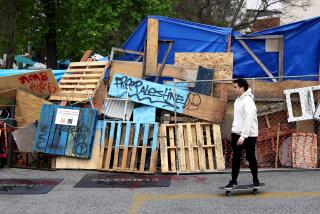Criticism of SDSU Imperial Valley Campus May Bring Changes
A critical outside review of academic offerings and the physical plant at the Imperial Valley campus of San Diego State University will result in a reappraisal of the direction the Calexico facility should take and what additional state funding might be required.
SDSU educators agreed this week with the sharp criticisms made last spring by the Western Assn. of Schools and Colleges that said the satellite campus offers too many courses with too few professors, has dilapidated buildings with peeling paint and poor acoustics, and an inadequate library to support its class offerings. The university commented publicly on the WASC findings for the first time this week.
Albert Johnson, SDSU vice president for academic affairs, said many of the shortcomings were cited in an internal May, 1988, report by San Diego State educators trying to get a handle on problems in the Imperial Valley, which he called a “one of a kind” arrangement in the state. San Diego State is the only Cal State university with satellite campuses.
Established in 1960
Johnson said a special committee of San Diego State and California State University officials will look at short- and long-range ideas to improve the campus, which was established in 1960 to offer upper-division undergraduate courses and graduate courses in teacher education. Those recommendations could include closer ties with Imperial Community College, the region’s only other post-secondary institution, Johnson said.
The dean of the Imperial Valley campus, David Ballesteros, said, “What needs to be emphasized is that we are part of the state of California, even though we happen to be along the border and have a large Hispanic population, and therefore we deserve the best in education just like everywhere else.”
The campus today offers nine undergraduate majors and a graduate degree in educational administration, with 21 full-time professors for 420 students, about 60% undergraduate, 73% women and 53% Latino.
Because of the campus’ small size--San Diego State’s main campus has 35,000 students and its upper-division North County center 2,000 students--it has found itself with several academic departments having only one full-time professor.
The Oakland-based WASC, which accredits universities in the West, said the tiny departments mean that students cannot receive the necessary depth in a particular field. In response, the university is attempting to merge department offerings into several interdisciplinary majors such as social studies or general humanities. In that manner, the school can offer thematic courses that draw upon a historian, a sociologist, a political scientist or an economist--in contrast to a specific major such as economics, which would require several professors in the field to cover the courses necessary for the specialized degree.
Stronger Curriculum
“I think that is a realistic restructuring” to meet some of the concerns of the WASC, Johnson said.
Steve Weiner, WASC executive director for university accrediting, agreed that a broader interdisciplinary offerings could result in a stronger curriculum without having to add substantially to the faculty. The WASC will review progress in three years.
But Ballesteros cautioned that too few majors may cause problems with state requirements that teachers planning to work in secondary schools have academic majors in specific fields rather than across disciplines.
And he said the larger issue is how to make the campus attractive to more students--many of whom do not want to leave the valley--by offering more majors and graduate degrees in subjects related to the growing binational ties between Mexicali and the Imperial Valley. Ballesteros suggested criminal justice, business, public administration and health as potential new disciplines that could meet valley needs.
Johnson agrees.
“Those are probably the four areas that are saleable in the valley,” he said. “I don’t think we’re going to be able to propose a general (four-year) liberal arts/science curriculum” in the foreseeable future.
Ballesteros said “all of this comes down to money, staffing commitment and good will--which goes beyond just San Diego State. . . . We have to interpret our needs” better to the CSU chancellor’s office and to state legislators.
Johnson said that historically, there has been little or no pressure from the valley community for a greater share of resources, with the result that the number of high school students who attend either a Cal State or University of California campus is less than half the lowest figures in counties elsewhere.
Almost 4,000 students attend Imperial Valley Community College, but most take vocational courses and do not transfer to four-year institutions, Johnson said.
More to Read
Sign up for Essential California
The most important California stories and recommendations in your inbox every morning.
You may occasionally receive promotional content from the Los Angeles Times.









